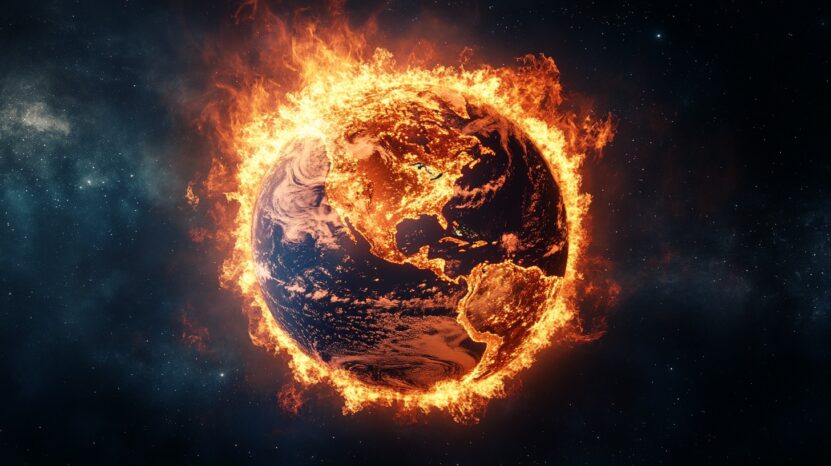Extreme heat events are becoming increasingly common across the globe, especially in regions like the United States. These weather phenomena pose serious risks to both humans and the environment.
One of the most alarming occurrences linked to these events is the emergence of “heat domes,” which can drastically elevate temperatures for extended periods.
Being fully aware of the mechanics and impacts of heat domes is crucial as we face the challenges of a warming planet.
What Is a Heat Dome?
A heat dome is a weather phenomenon that occurs when a region of high-pressure atmospheric conditions traps warm air over an area. This results in prolonged periods of extreme heat, often lasting for days or even weeks.
Picture placing a lid over a boiling pot of water – the steam has nowhere to escape, causing the water to get hotter and hotter.
Similarly, a heat dome acts like a lid on the atmosphere, trapping hot air close to the ground and preventing cooler air from entering the region.
Unlike typical heatwaves, which may last for shorter durations and move as weather systems shift, a heat dome can persist and linger, intensifying the heat.
The high-pressure system keeps the warm air stagnant, making it feel more oppressive over time. This can significantly impact not only temperature but also air quality, leading to health concerns for those exposed to these conditions for prolonged periods.
- Acts like a lid, trapping heat and preventing cool air from entering.
- Can cause prolonged periods of high temperatures over large areas.

How Does a Heat Dome Form?
The formation of a heat dome begins with high-pressure systems in the upper atmosphere stalling over a particular region.
When these systems become stationary, they create a barrier that traps warm air beneath them. This air, already heated by the sun, becomes even hotter as it is unable to escape.
The absence of cloud cover in many cases exacerbates the situation by allowing more solar radiation to penetrate, further raising temperatures.
Another key factor in the formation of heat domes is the behavior of the jet stream. When the jet stream bends in large, persistent patterns, it can create ideal conditions for trapping heat over wide geographic areas.
- High-pressure systems trap warm air.
- Jet stream disturbances contribute to the persistence of the heat dome.
Impact of Heat Domes on Temperatures

Heat domes are notorious for drastically elevating temperatures, often causing them to rise between 11-16°C (20-30°F) above normal. The intensity and duration of these events can vary, with some heat domes lasting only a few days, while others persist for weeks.
Prolonged exposure to extreme heat can have severe consequences for human health, agriculture, and infrastructure.
Recent examples of heat dome events have been witnessed in the United States, Mexico, and Europe, where temperatures soared to dangerous levels.
- Record-breaking temperatures
- Wildfires
- Strained energy grids
These events are not isolated incidents but part of a broader trend of increasingly frequent and intense heat waves driven by changing climate patterns.
- Temperatures can spike 20-30°F above normal.
- Heat domes have recently impacted areas in the U.S., Europe, and Mexico.
Heat Domes and Climate Change
The link between heat domes and climate change is becoming more evident. As the Earth’s atmosphere warms due to rising greenhouse gases, the conditions that lead to the formation of heat domes are becoming more favorable.
Not only are heat domes occurring more frequently, but they are also becoming more intense, with higher temperatures and longer durations.
- Ecosystems
- Human health
- Agriculture
Prolonged exposure to extreme heat can cause heatstroke, dehydration, and respiratory issues, particularly in vulnerable populations such as the elderly and young children.
Agriculture is also severely impacted as crops struggle to survive in such high temperatures, leading to reduced yields and food insecurity.
The global rise in temperatures is contributing to a feedback loop, where climate change fuels more heat domes, which in turn exacerbate the warming of the planet.
- Climate change increases the frequency and intensity of heat domes.
- Impacts include health risks, reduced agricultural productivity, and environmental degradation.
Preventing and Mitigating the Effects of Heat Domes
While we cannot completely prevent the occurrence of heat domes, there are measures individuals and societies can take to mitigate their effects.
During a heat dome event, individuals should stay hydrated, avoid outdoor activities during peak heat hours, and conserve energy to prevent overloading power grids.
Communities can establish cooling centers where people can seek relief from the heat, especially in urban areas where temperatures tend to be higher due to the urban heat island effect.
In the long term, mitigating the effects of heat domes involves addressing the root cause: climate change.
Reducing reliance on fossil fuels, transitioning to renewable energy sources, and improving energy efficiency are crucial steps in slowing the pace of global warming.
- Short-term actions include hydration, staying indoors, and using cooling centers.
- Long-term actions focus on reducing fossil fuel consumption and improving infrastructure.
The Bottom Line
Knowing all there is to know about heat domes is essential in the context of rising global temperatures and extreme weather events.
As the frequency and intensity of these events increase, both global and individual actions are necessary to address the underlying causes of climate change and protect vulnerable populations from the dangers of extreme heat.

